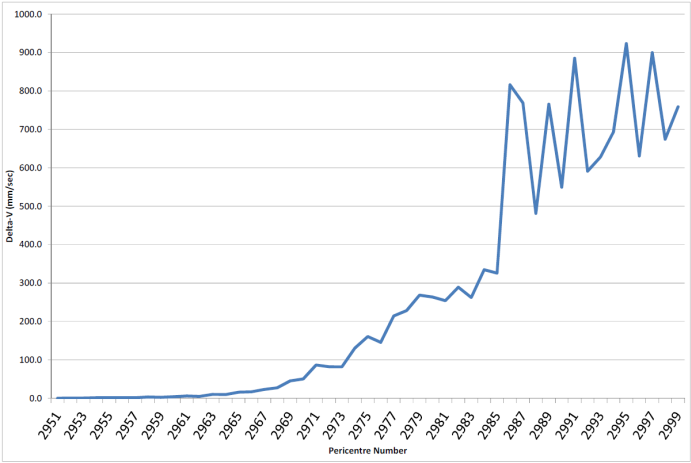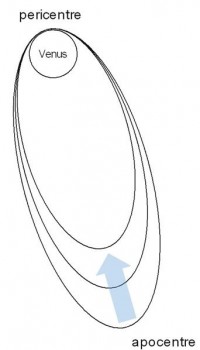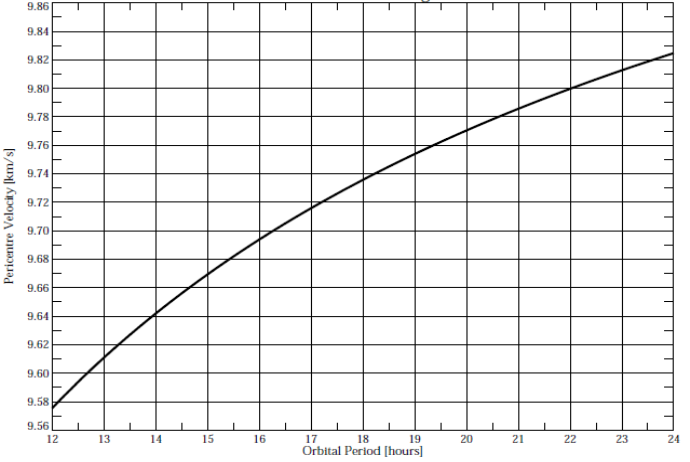Today’s post was submitted by Colin Wilson, Venus Express science operations coordinator.
Venus Express is now in the final week of its aerobraking campaign, and is about as low as it’s going to get. At its last pericentre passage, its altitude was only 129.9 km and this is expected to decrease to 129.1 km before the end of the aerobraking campaign.
When it passes through the atmosphere at some 10 km/second, onboard temperature sensors are now showing that we are heating the spacecraft as much as we dare, any more and there is a real risk of damaging the spacecraft.
As explained in previous posts (23 June, 3 July), the VEx team are aiming for altitudes at which the dynamic pressure – the drag force exerted on the spacecraft by the atmosphere – is in the range 0.40 to 0.60 N / m^2, with a goal of having at least 3 pericentre passes at dynamic pressures of over 0.50 N/m^2. Dynamic pressures in some of the latest aerobraking passes have reached 0.55 N/m^2, so the target has evidently been achieved.

Predicting the dynamic pressure that will be encountered is difficult because the atmospheric density can vary dramatically from orbit to orbit. The above plot shows how much deceleration the spacecraft experiences during the aerobraking pass (the deceleration experienced by the spacecraft is proportional to the dynamic pressures encountered, which in turn are proportional to the atmospheric density). The plot shows that the spacecraft’s velocity decreases by anywhere between 0.5 and 1.0 m/s (this is equal to 1.8 to 3.6 km/h). Decelerations have been increasing because the spacecraft’s altitude has been decreasing, bringing the spacecraft lower, into denser parts of the atmosphere. The sudden jump at pericentre = 2986 occurs because the spacecraft altitude was lowered on that day (23 June); apart from these large changes, the variations show day-to-day variability of the atmosphere. Scientists will be studying these variations to understand to what extent they are caused by atmospheric waves propagating up from weather systems below, and to what extent they are influenced by variations in solar activity and other causes.
 This plot also serves as a reminder of why aerobraking is interesting in the first place; it is a way of decelerating the spacecraft’s velocity and therefore changing its orbit. Slowing the spacecraft down at pericentre has the effect of lowering the apocentre altitude (pericentre is when the spacecraft is at its closest to the planet; apocentre is when it’s at its furthest). If continued for long enough, aerobraking can be used to reach a circular orbit (as opposed to the highly elliptical orbit such as the one Venus Express is in now).
This plot also serves as a reminder of why aerobraking is interesting in the first place; it is a way of decelerating the spacecraft’s velocity and therefore changing its orbit. Slowing the spacecraft down at pericentre has the effect of lowering the apocentre altitude (pericentre is when the spacecraft is at its closest to the planet; apocentre is when it’s at its furthest). If continued for long enough, aerobraking can be used to reach a circular orbit (as opposed to the highly elliptical orbit such as the one Venus Express is in now).
Aerobraking was used by NASA’s Mars Reconnaissance Orbiter to reach a low circular orbit needed for high resolution imagery and will also be used by ESA’s ExoMars orbiter. The aerobraking campaign being conducted by Venus Express is only a few weeks long and will lead to only a small change in the orbit. However, with this aerobraking campaign, ESA is gaining operational experience of aerobraking, which it will use for future missions.
 In addition to lowering the apocentre altitude, aerobraking reduces the orbital period, that is the time it takes to complete an orbit around Venus. In this aerobraking campaign to date, the velocity at pericentre has been decreased a total of just over 10 m/s (36 km/h). This relatively small reduction in pericentre velocity is enough to reduce the orbital period from 24 h to 23 h (as shown in the plot below). As we perform a few more orbits of aerobraking this week the orbital period will be reduced even further.
In addition to lowering the apocentre altitude, aerobraking reduces the orbital period, that is the time it takes to complete an orbit around Venus. In this aerobraking campaign to date, the velocity at pericentre has been decreased a total of just over 10 m/s (36 km/h). This relatively small reduction in pericentre velocity is enough to reduce the orbital period from 24 h to 23 h (as shown in the plot below). As we perform a few more orbits of aerobraking this week the orbital period will be reduced even further.
And finally: you may have noticed in the plots that Venus Express has reached its 3000th pericentre, in other words it has completed 3000 orbits around Venus (it reached this milestone on Monday 7 July). Reaching this milestone is especially impressive given that the spacecraft was originally designed for a nominal science mission of only 500 orbits!

Discussion: no comments